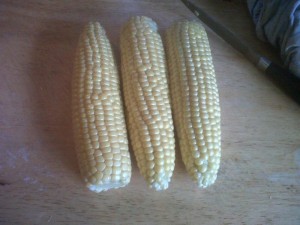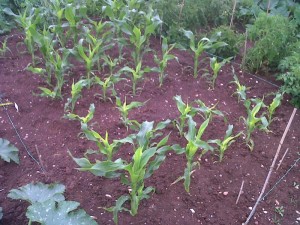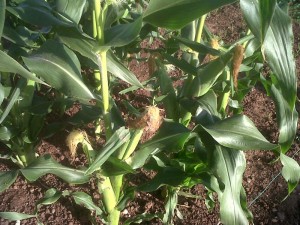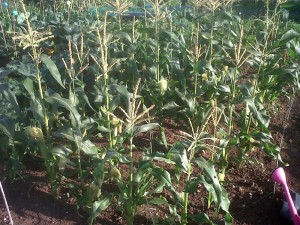 Growing sweetcorn at home is a rewarding experience. There is nothing like the sweet taste of freshly picked corn and it is surprisingly easy to grow sweetcorn when you know how.
Growing sweetcorn at home is a rewarding experience. There is nothing like the sweet taste of freshly picked corn and it is surprisingly easy to grow sweetcorn when you know how.
Firstly you will need to allocate some space on your allotment or in your garden to grow your sweetcorn. This needs to be a square area. Sweetcorn is always planted in a square because it allows for proper pollination of the plants. The male flowers are found at the top of the sweetcorn and the square block formation allows for pollination of the female flowers lower down which produce the corn.
Sweetcorn grows best in free draining soil that will retain moisture. If you can plan in advance, then dig in plenty of well rotted manure in to your new sweetcorn bed. If you don’t have the time to do this, you can still prepare the bed in the spring by removing weeds and digging over the site. Make sure you remove any large stones before you level it roughly and then rake flat.
Seeds or Plants
You can buy ready seeds or pre-grown sweetcorn. It is up to you which you prefer – the ready made sweetcorn does save some time and can mean an earlier crop. However, you have a lot less choice in the varieties available to you with the per-grown plants. If you want to grow a heritage or more unusual crop then you will have to start from seed.
Sowing In To Pots
You can start growing sweetcorn in pots in April. Fill a 7.5cm pot with a good quality compost and then make a 2.5cm deep hole in the top with a pencil or dibber. Drop to seeds in to the hole, cover and water. Place in a warm, light position, such as a windowsill to germinate.
When the seedlings reach around 2cm in height, remove the smallest one and put the plants in a shady place outside where they can toughen up a bit before you plant them out.
Before you plant out your sweetcorn, rake in some general fertiliser to your sweetcorn plot 2 or 3 weeks before you plant or sow your sweetcorn.
You want to set your sweetcorn plants around 35cm between plants and around 60cm between rows, forming a block. The block can be as large as you want it to be, depending on how many plants you are going to plant.
Sowing Direct To Soil
You can sow direct in to the soil instead of starting the plants off in pots. Plant the seeds in 2.5cm deep holes in late spring or early summer. Remember to sow two seeds every 35cm with 60 between the rows. Cover and water. When the seedlings reach 2cm tall then remove the weakest plant.
If it the weather is cool then you may want to protect the sweetcorn with fleece, held down with stones.
Making The Most Of Your Space
Sweetcorn has a relatively long growing season and does take a lot of space, which puts off a lot of allotment gardeners from growing it. However, the space where you are growing your sweetcorn doesn’t have to be just dedicated to your sweetcorn, you can grow other plants there too.
You can plant faster growing crops in between the sweetcorn to maximize the usage of the space. Growing lettuce, spring onions and radishes works very well with sweetcorn. These grow quickly whilst the sweetcorn is small and then as the corn grows bigger, you harvest the faster growing plants and make the most of that block of earth!
Harvesting Sweetcorn
Your sweetcorn will be ready when the silky tassels on the end of each cob has turned brown. You can be sure by carefully peeling back the leaves surrounding the cob and pinching a kernel. You are looking for milky juice, which means they are ready.
Then just twist the cob to remove it from the plant. You can remove one cob at a time from the plants and then remove the excess leaves from the cob and put in your compost heap before taking it home.
Storing Sweetcorn
It is better to leave the cobs on the plant until you are ready to use them, but you can store them at home. Leave the sweetcorn in the husks (leaves) and store in the crisper drawer of your fridge. Remember that sweetcorn doesn’t store well and loses its sweetness over time, so realistically you can only store them for a couple of days.
You can freeze the corn on the cobs by removing the husks and silk and then blanching the ears of corn in boiling water for 7 to 11 minutes. Drain them and plunge them in to cold water to stop the cooking. Dry them off and drain them as best you can then put them in freezer safe bags. Remove as much as as possible (vacuum sealers are useful here) and put in your freezer where they will keep for up to a year.
It is possible to freeze the kernels of the corn instead by removing the husks and then using a knife to remove the kernels. In most cases you are only going to get about three quarters of the total depth of the kernel. Blanch the kernels in boiling water for 5 minutes then drain and place in cold water. Dry and place in freezer safe bags, removing as much air as you can. Typically these will be good for around 3 months.
Sweetcorn is fun to grow and homegrown sweetcorn has a delicious sweet flavour that is heavenly. My kids won’t eat corn on the cob normally, but I couldn’t stop them eating the ones I’d grown on the allotment. It will be repeated next year in a larger area!


























